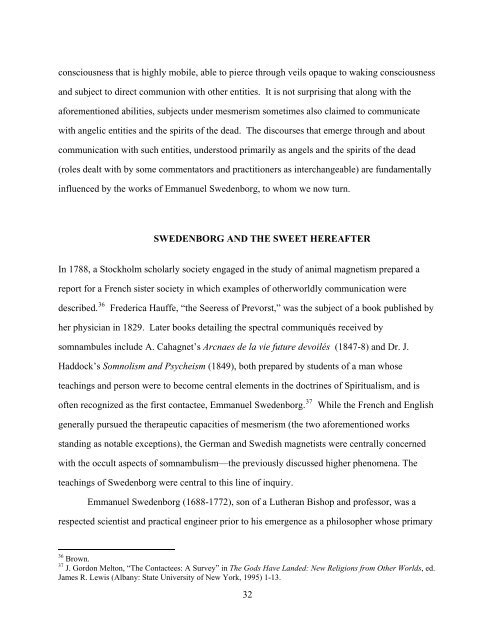A Genealogy of the Extraterrestrial in American Culture
A Genealogy of the Extraterrestrial in American Culture
A Genealogy of the Extraterrestrial in American Culture
Create successful ePaper yourself
Turn your PDF publications into a flip-book with our unique Google optimized e-Paper software.
consciousness that is highly mobile, able to pierce through veils opaque to wak<strong>in</strong>g consciousness<br />
and subject to direct communion with o<strong>the</strong>r entities. It is not surpris<strong>in</strong>g that along with <strong>the</strong><br />
aforementioned abilities, subjects under mesmerism sometimes also claimed to communicate<br />
with angelic entities and <strong>the</strong> spirits <strong>of</strong> <strong>the</strong> dead. The discourses that emerge through and about<br />
communication with such entities, understood primarily as angels and <strong>the</strong> spirits <strong>of</strong> <strong>the</strong> dead<br />
(roles dealt with by some commentators and practitioners as <strong>in</strong>terchangeable) are fundamentally<br />
<strong>in</strong>fluenced by <strong>the</strong> works <strong>of</strong> Emmanuel Swedenborg, to whom we now turn.<br />
SWEDENBORG AND THE SWEET HEREAFTER<br />
In 1788, a Stockholm scholarly society engaged <strong>in</strong> <strong>the</strong> study <strong>of</strong> animal magnetism prepared a<br />
report for a French sister society <strong>in</strong> which examples <strong>of</strong> o<strong>the</strong>rworldly communication were<br />
described. 36<br />
Frederica Hauffe, “<strong>the</strong> Seeress <strong>of</strong> Prevorst,” was <strong>the</strong> subject <strong>of</strong> a book published by<br />
her physician <strong>in</strong> 1829. Later books detail<strong>in</strong>g <strong>the</strong> spectral communiqués received by<br />
somnambules <strong>in</strong>clude A. Cahagnet’s Arcnaes de la vie future devoilés (1847-8) and Dr. J.<br />
Haddock’s Somnolism and Psycheism (1849), both prepared by students <strong>of</strong> a man whose<br />
teach<strong>in</strong>gs and person were to become central elements <strong>in</strong> <strong>the</strong> doctr<strong>in</strong>es <strong>of</strong> Spiritualism, and is<br />
<strong>of</strong>ten recognized as <strong>the</strong> first contactee, Emmanuel Swedenborg. 37<br />
While <strong>the</strong> French and English<br />
generally pursued <strong>the</strong> <strong>the</strong>rapeutic capacities <strong>of</strong> mesmerism (<strong>the</strong> two aforementioned works<br />
stand<strong>in</strong>g as notable exceptions), <strong>the</strong> German and Swedish magnetists were centrally concerned<br />
with <strong>the</strong> occult aspects <strong>of</strong> somnambulism—<strong>the</strong> previously discussed higher phenomena. The<br />
teach<strong>in</strong>gs <strong>of</strong> Swedenborg were central to this l<strong>in</strong>e <strong>of</strong> <strong>in</strong>quiry.<br />
Emmanuel Swedenborg (1688-1772), son <strong>of</strong> a Lu<strong>the</strong>ran Bishop and pr<strong>of</strong>essor, was a<br />
respected scientist and practical eng<strong>in</strong>eer prior to his emergence as a philosopher whose primary<br />
36 Brown.<br />
37 J. Gordon Melton, “The Contactees: A Survey” <strong>in</strong> The Gods Have Landed: New Religions from O<strong>the</strong>r Worlds, ed.<br />
James R. Lewis (Albany: State University <strong>of</strong> New York, 1995) 1-13.<br />
32















